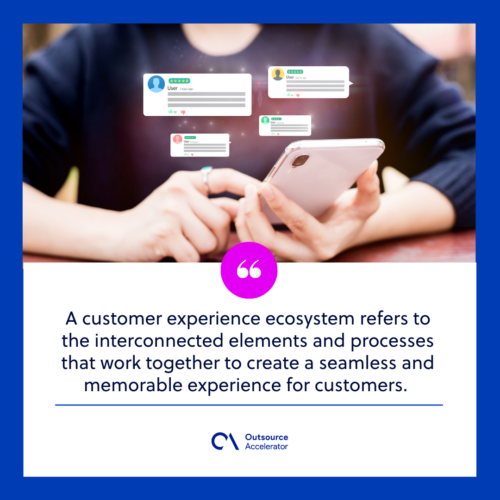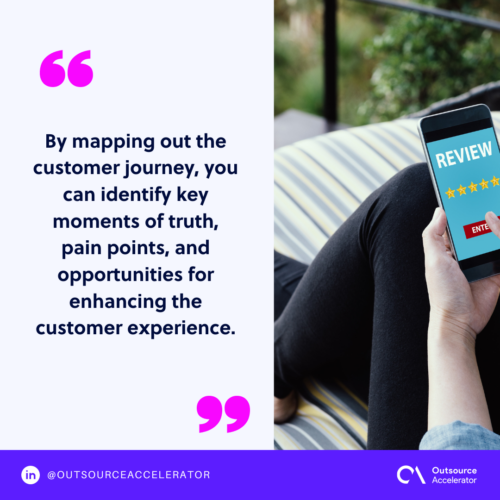Customer experience ecosystem: Your gateway to exceptional customer experience

Providing exceptional customer experience has become a critical differentiator in today’s business landscape.
Customers have higher expectations and demand personalized, seamless interactions across various channels and touchpoints. Building a robust customer experience ecosystem is the key to meeting these demands and maximizing the effort to provide the best services.
This article explores the aspects of a customer experience ecosystem, its building blocks, and the prerequisites for its success.
Understanding the customer experience ecosystem
A customer experience ecosystem refers to the interconnected elements and processes that work together to create a seamless and memorable experience for customers.
It encompasses every customer interaction with a brand, from initial awareness to post-purchase support.
Customer experience ecosystem contains various digital and physical elements that collectively shape and influence the customer’s perception and overall experience.
In this interconnected ecosystem, every customer interaction with a brand matters. Whether browsing a website, making a purchase, or engaging with the brand on social media, each touchpoint contributes to the overall impression and satisfaction of the customer.
Therefore, organizations must create a seamless and consistent experience across all these ways. Brands can ensure increased customer satisfaction and loyalty through this effort.

Why you should build a customer experience ecosystem
A customer experience ecosystem is essential for any business that wants to create a sustainable competitive advantage.
Here are the key reasons why you should build a customer experience ecosystem:
- Improve customer satisfaction and loyalty. A customer experience ecosystem can help you create a more personalized and relevant experience that meets your customers’ needs and expectations.
- Increase customer retention and repeat business. Customers are more likely to return to your brand and do business with you again when they have a positive experience with your company.
- Reduce customer churn and negative word-of-mouth. A poor customer experience can lead to negative word-of-mouth. By investing in a customer experience ecosystem, you can identify and address pain points and opportunities to improve your services.
- Increase profitability. Happy customers are more likely to spend more money with your brand and recommend you to others, which can lead to increased sales and revenue.
- Differentiate yourself from competitors. A customer experience ecosystem can help you stand out. By creating a unique experience, you can stand out in your market as well as attract and retain customers.
Customer experience ecosystem building blocks
A successful customer experience ecosystem requires several key building blocks working together.
Let’s explore each of these building blocks:
Customer-centric culture
A customer-centric culture requires a shift in mindset and a commitment to putting the customer first in all decision-making processes. This means that all employees, from the CEO to the front-line staff, must be aligned with the company’s customer-centric vision.
When a company has a customer-centric culture, it can better understand its customers’ needs, expectations, and pain points. This creates a more personalized and relevant experience.
Journey mapping and touchpoint analysis
Journey mapping and touchpoint analysis are essential for understanding the customer journey and identifying pain points and areas of opportunity.
Journey mapping involves mapping the customer journey from start to finish, while touchpoint analysis involves identifying every customer interaction with a company.
By understanding the customer journey and touchpoints, companies can identify pain points and opportunities to improve the customer experience. This can involve optimizing touchpoints, removing friction, and creating a more personalized and relevant experience.
Personalization
Personalization is the process of tailoring a customer’s experience to their specific needs and preferences. It uses data and insights to create a personalized experience that meets the customer’s needs.
Personalization can involve various tactics, such as personalized recommendations, content, and offers. It helps create a more relevant and engaging experience that strengthens the customer’s relationship with the brand.
Omnichannel experience
An omnichannel experience involves creating a seamless and consistent experience across all channels and touchpoints. It consists of integrating all channels, including online, offline, and mobile, to create a seamless and consistent experience for customers.
An omnichannel experience requires a deep understanding of the customer journey and touchpoints and the ability to integrate various systems and technologies.
It can create a more convenient and engaging experience that meets the customer’s needs and preferences.

Exceptional employee engagement
Employee engagement is critical to creating an exceptional customer experience. Engaged employees are more likely to go above and beyond to satisfy customers and create a positive experience.
Companies that invest in employee engagement are more likely to have engaged and motivated employees who are committed to delivering exceptional customer service.
Exceptional employee engagement involves creating a positive work environment. Organizations must provide training and development opportunities, and recognize and reward employees for their contributions.
Elements of a customer experience ecosystem
A customer experience ecosystem comprises various interconnected elements that create a holistic experience. Some essential features include:
- Brand identity and positioning. At the core of the customer experience ecosystem is a well-defined brand identity and positioning. It humanizes the brand, giving it personality and character, which helps build emotional connections with customers.
- Customer segmentation. This is where organizations segment their customer base and create buyer personas. Customer segmentation involves identifying distinct customer groups based on demographics, behaviors, and preferences.
- Customer insights. Brands can gain valuable insights from existing customer data, such as transaction history, website interactions, and social media engagement.
- Feedback and sentiment analysis. Actively seeking and analyzing customer feedback through surveys, social media monitoring, and online reviews is essential for understanding satisfaction levels and identifying areas for improvement.
- Technology infrastructure. Investing in robust technology infrastructure, including CRM systems, marketing automation platforms, and customer support software, allows organizations to effectively manage and leverage customer data.
- Team collaboration. Delivering a great customer experience requires collaboration across different departments and teams within an organization.
- Continuous optimization. The customer experience ecosystem is dynamic, and organizations must continuously monitor and optimize their efforts through performance indicators, metrics, and feedback.
Prerequisites to a successful customer experience ecosystem
Companies must fulfill certain requirements needed to build a successful customer experience ecosystem.
Understanding your company’s ecosystem
Firstly, it is crucial to have a deep understanding of your company’s internal and external ecosystem. This involves comprehending the organization’s culture, values, goals, and business processes.
By gaining a holistic understanding of how different departments and functions within the company operate, you can identify potential challenges and opportunities for improving the customer experience.
For example, a company operating in a highly-regulated industry such as banking must ensure that its customer experience initiatives align with the legal requirements. Their processes must comply with PCI certifications to protect their customer’s financial data.
Understanding the regulatory landscape helps design customer experiences that meet customer needs and adhere to industry regulations.
Recognizing your CX hierarchy
Recognizing the hierarchy of customer experience (CX) within your organization is vital for effectively implementing a successful ecosystem.
You must understand the different touchpoints and customer interactions with your company across their journey. By mapping out the customer journey, you can identify key moments of truth, pain points, and opportunities for enhancing the customer experience.
For instance, a retail company may recognize that the in-store experience is a critical touchpoint in its CX hierarchy. The company can elevate the in-store experience and differentiate itself from competitors by:
- Investing in well-trained and knowledgeable staff
- Creating an inviting store environment
- Offering personalized recommendations

Applying the CX ecosystem
Applying the CX ecosystem involves implementing strategies, processes, and technologies to deliver a seamless and exceptional customer experience. Align customer-centric initiatives across all touchpoints, integrate data and analytics to gain customer insights, and leverage technology to personalize interactions.
An e-commerce company, for example, can utilize data analytics to analyze customer behavior and preferences.
Using this insight, the company can recommend personalized products or send targeted offers to individual customers, creating a more personalized and relevant shopping experience.
Maintaining CX strength
Maintaining a strong customer experience requires ongoing dedication and effort. You should continuously monitor and measure CX initiatives’ effectiveness, gather customer feedback, and adapt strategies based on customer insights.
It is essential to have a customer-centric culture that permeates throughout the organization. Every employee must understand the importance of delivering exceptional customer experiences.
For instance, a hospitality company may regularly collect customer feedback through post-stay surveys and online reviews.
Mapping your customer experience ecosystem
Mapping out your entire company ecosystem helps you manage a customer experience ecosystem. By creating a comprehensive map, businesses gain a holistic view of their ecosystem and can identify areas for optimization and innovation.
A well-designed customer experience ecosystem serves as the gateway to exceptional customer experience.
Third-party solutions providers like Datamatics cater to growing firms as they specialize in refining the overall customer experience.
By understanding the building blocks, elements, and prerequisites, businesses can create a cohesive, customer-centric environment that drives satisfaction, loyalty, and business growth.
Investing in a robust ecosystem sets you apart from the competition and ensures your customers receive the exceptional experiences they deserve.







 Independent
Independent




